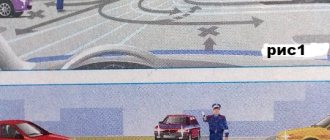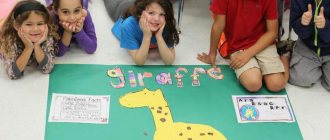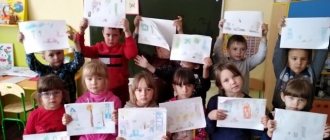Tasks and forms of work on traffic rules in preschool educational institutions
Tasks and forms of work in different age groups on traffic rules
Early age group Tasks: - introduce children to the vehicles of their immediate environment; - learn to distinguish and name some of them; - distinguish the parts of the machine and name them. Forms of work: - teacher’s story about types of transport (using illustrations and toys); - reading literary works; — examination of the paintings “City Street”, “Transport”; — role-playing game “We are drivers”; - acting out situations; — didactic game “Assemble a car.” Children should: - recognize some types of vehicles; - show the parts of the machine and name them. Group: junior Objectives: - introduce children to the operation of traffic lights; - form ideas about the street; — learn to distinguish between types of ground transport. Forms of work: - teacher’s story about types of transport (using illustrations); — targeted walk “Getting to know the street”; — reading poems by V. Lebedev-Kumach from the collection “About Smart Animals”; — examination of the paintings “City Street”, “Transport”; — role-playing game “We are drivers”; — viewing of puppet shows “Respect the traffic light”, “An incident in the forest”; — applications on the themes: “Fun Train”, “Traffic Light”; — targeted walk “Observing the operation of a traffic light”; — didactic game “Assemble a traffic light.” Children should: - know how a traffic light works (name its signals), at what signal it is possible to cross the roadway; — master the concepts: driver, passenger, pedestrian; use them in speech; — know the names of vehicles: passenger car; vehicles: truck, ambulance, fire truck; tram, bus, train; - have an idea of what a roadway or sidewalk is. Group: medium Objectives: - clarify children’s knowledge about the purpose of a traffic light; — introduce the classification of types of urban transport, develop skills of cultural behavior in transport; — expand the understanding of the street, roadway, provide basic knowledge about the rules of safe behavior. Forms of work: - story “The street on which the kindergarten is located”; - reading the works of S. Mikhalkov “My Street”, “Traffic Light”, M. Druzhinina “Our Friend the Traffic Light”; — targeted walk “Pedestrian crossing”; — viewing photographs of “Streets of our city”; — drawing “Truck”; — designing “Our Street”; — didactic game “Transport”; — viewing of puppet shows “Respect the traffic light”, “An incident in the forest”; - outdoor games to develop coordination of movements; — conversation “Let's be polite”; — games at the tabletop crossroads; — fairy tale game “Pedestrian ABC”; — puppet show “An Incident in the Forest”; — watching thematic cartoons. Children should: - name all the traffic lights and talk about their meaning: red, yellow - “stop”, green - “make sure it’s safe and go”; - learn different types of transport; be able to classify them: water, air, land; - name the rules of behavior in transport, on the street; - know where you can cross the roadway. Group: senior Objectives: - continue to consolidate and supplement the understanding of some traffic rules; — cultivate a culture of behavior on the street and in transport; — introduce children to road signs: “Pedestrian crossing”, “Pedestrian traffic is prohibited”, “Children”, “Tram stop”, “Bus stop”, “Medical aid station”, “Food station”, “Parking area”, “Road work", "Entry prohibited". Forms of work: - targeted walk “Road Signs”; - teacher’s story about the rules for safe street crossing; — watching the puppet show “Respect the traffic light”; - reading works on relevant topics; — examination of the painting “City Street”; — collective drawing on the theme “Street of our city”; — learning songs from the collection “School of Road Sciences”; — didactic games: “Walk around the city”, “Road signs”; — role-playing game “At the Crossroads”; — theatrical production “The Road to the Terem”; — solving problem situations at table crossings; — games at the training intersection; — watching thematic cartoons; — completing tasks in workbooks. Children must: - know the road signs: “Pedestrian crossing”, “Pedestrian traffic is prohibited”, “Children”, “Tram stop”, “Bus stop”, “Medical aid station”, “Food station”, “Parking area”, “ Road works", "Entry prohibited"; - have an understanding of the basic rules of the road; - recognize different types of transport, be able to explain their purpose; - name the rules of behavior in transport, on the roadway. Group: preparatory Tasks: - continue to introduce road signs: warning, prohibitory, informational signs; — improve the culture of behavior on the street and in transport; — introduce the work of a traffic controller. Forms of work: - examination of pictures with different types of transport, their classification: passenger, construction, military, etc.; — acquaintance with the work of adults — observation of the work of a traffic controller; — didactic games: “Road Signs”, “Put a Sign”, “Street”, “Pedestrian”; — targeted walk “Crossroads”; - compiling a story based on the painting “Policeman-Traffic Controller”; — obligatory conversation “The road is not a place for games”; — drawing on the topic “Remember the rules of the road”; — application on the theme “Road signs”; — design on the theme “Bus”; - reading works on relevant topics; — role-playing game “Traffic Controller”; — watching the puppet show “Respect the traffic light”; — examination of paintings and posters “Rules of conduct on the street”; — solving problem situations at table crossings; — games at the training intersection; — musical and gaming leisure “Remember the rules of the road!”; - campaign “Driver! Save my life!”; — sports leisure for parents and children “Visiting the traffic light”; - joint compilation of a collage by children and parents “My Yard”; — production of the “Family of Road Signs”; — solving puzzles and crossword puzzles “Road ABC”; — learning songs from the collection “School of Road Sciences”; — leisure time together with 1st grade students “Study the rules of the road”; — watching thematic cartoons; — completing tasks in workbooks; — conversation with a traffic police inspector. Children must: - be able to solve problem situations that arise on the roadway and in the yard; - recognize different types of transport, be able to classify: passenger, construction, military; - have an understanding of the work of the traffic controller and his functions; - be able to classify road signs: warning, prohibitory, informational. Information for teachers Before starting teaching preschoolers, teachers themselves need to know and follow the rules of the road. Therefore, the organization of consultations, workshops, and exhibitions of specialized literature is an integral part of the work on the prevention of child road traffic injuries in preschool institutions. Conducting competitions (“Designing a traffic corner for children”, “The best development of a lesson on teaching children the rules of safe behavior on the streets and roads of the city”, etc.) also contributes to the manifestation of creative activity and initiative of teachers. Be sure to involve traffic police inspectors in your classes, because they will be able to provide the most complete and reliable information about traffic rules, provide an analytical report on the state of urban transport and children's road traffic injuries. Road safety corners in preschool educational institutions
We recommend watching:
Role-playing game on traffic rules for the senior group Photo report of the holiday in the senior group on traffic rules Do-it-yourself didactic game on traffic rules for a kindergarten Summary of the GCD on traffic rules in the middle group on the topic: Road alphabet
Similar articles:
Layout for learning traffic rules with preschoolers
Scenario of a children's summer holiday on traffic rules in the 1st junior group with parents
Project on traffic rules in the senior preparatory group “Children and the Road”
Long-term work plan on the topic: “Education of the fundamentals of safe behavior in preschool children” with children 6-7 years old
Working with preschoolers on traffic rules
Elena Kiryushina
Working with preschoolers on traffic rules
For several years, I have been systematically working to teach children the rules of the road and instill the skills of disciplined, cultural behavior on the streets and roads .
Preschool education program “From birth to school”
edited by N. E. Veraksa, T. S. Komarova, M. A. Vasilyeva provides for teaching children
traffic rules from the second junior group. The work plan included such forms of work with children according to traffic rules as excursions, observations, conversations, looking at pictures, reading works, memorizing poems, various didactic and role-playing games. In my work to familiarize children with the rules of the road, I also focus on the program “Fundamentals of the safety of
preschool ” by R. B. Sterkina, O. L. Knyazeva, N. N. Avdeeva, namely the section “Child on the streets of the city.”
Starting from the second junior group of kindergarten, I work to familiarize children with various types of transport, to educate children in the ability to behave correctly the roadway .
Traffic rules require the child to navigate in space and correctly to changes in the environment. To achieve success in mastering traffic rules , I make connections between all sections of the program. In organized educational activities in all educational areas and other types of activities, I pay attention to the formation of spatial orientation in children, the development of a quick reaction to changes in the environment.
to the rules of the road systematically and consistently, complicating the program requirements from educational activity to educational activity and from group to group. In the junior and middle groups during: targeted walks, in educational activities, in games, I direct children’s attention to the movement of pedestrians and vehicles , I name the colors of the traffic light, introduce the street, with the words: “traffic light”
,
“sidewalk”
,
“pedestrian”
,
“crosswalk”
,
“car”
. I specify the name of the parts of the car: cabin, wheels, doors, etc. The knowledge acquired during the walk by the pupils is consolidated in the process of educational activities: on the application - gluing a traffic light;
on the formation of elementary mathematical concepts - they are taught to distinguish between the left and right sides ; in design - the construction of a street, a road . And I accompany the actions with the words: “We will have a sidewalk, who will walk on it?”
.
In the educational field “physical education”
I teach kids to move in a certain
direction - forward , backward. They conduct outdoor games : “Train”
,
“Tram”
,
“Sparrows and Cars”
,
“Find Your Color”
.
Thus, children gain experience moving along the street , their vocabulary is enriched, and the level of spatial orientation increases.
In the senior and middle groups, I connect scattered information about traffic rules into a consistent and harmonious system of ideas. Children of these groups clearly know and practically use the existing knowledge of traffic rules on the street , know road signs , and know about the work of traffic police officers . In the older group, I practice traffic rules in various games . All children in the older group can practically cross the street and clearly know the way from home to kindergarten.
At the end of 2022, entertainment was held for children of all age groups to consolidate children's knowledge of the rules of the road : “ Road ABC ”
.
The ability to apply traffic rules is taught to children on the basis of methodological literature available in preschool educational institutions: “Methodological recommendations for teaching preschool children traffic rules ”, St. Petersburg, 1994; "How to ensure the safety of preschoolers "
, K. Yu. Belaya, V. N. Zimonina, L. A. Kondrykinskaya and others, M. “Prosveshchenie”, 2004;
“
For preschoolers about the rules of the road ” , E. Ya. Stepanenkova, M. F. Filenko, M. “Prosveshchenie”, 1979;
“Safety on the streets and
roads ” , N. N. Avdeeva, O. L. Knyazeva, R. B. Sterkina, M. D. Makhaneva, M. LLC
Publishing House AST-LTD
, 1997;
Methodical manual “Teach
preschoolers the rules of movement ” , V. Klimenkov.
The group has created a “traffic rules corner”
, where visual and game material on
traffic rules . The material is replenished and updated throughout the academic year. Children independently play familiar games and look at illustrations without adult intervention. To improve work with children, I made street models with intersections, road signs , and traffic lights with my own hands.
Throughout the year I introduce children to fiction about traffic rules :
• Dorokhova A. "Green, yellow, red"
• Zhidkov B. “What I saw, traffic light”
• Northern A. “3 wonderful colors”
• Klimenko V. “Who is more important than anyone in the world!”
• "The Toy Incident"
• Turutin S. “What is a traffic light for?”
• Mikhalkov S. “My Street”
,
“Cyclist”
• Marshak S. “Policeman”
,
“Ball”
an important role in familiarizing children with the rules of the road . I do a lot of work on traffic rules with parents , introduce them to program requirements, and involve them in the production of material for educational activities, games, and performing various tasks with children. For example, parents and their children completed work at home on the theme “My Street”
, and an exhibition
of works on traffic rules . Together with parents, a corner for parents was set up with various poster consultations on traffic rules :
• “Child in a car”
• "Exploring the Responsibilities of Pedestrians"
etc.
Conversations were held with parents on the following topics:
• “How to teach your child not to fall into typical road traps ”
In April 2022, the preschool educational institution held an Open Day for parents, when it showed open classes, story-based didactic games with children on the topic “Prevention of DDTT”
.
In the 2018/2019 academic year, work was carried out to teach the rules of safe behavior on the roads and prevention of child road traffic injuries through consultations:
• “The main sections of the program for teaching children traffic rules. Their implementation through different types of children's activities in different age groups"
• “Organization and conduct of various forms of joint activities between the teacher and children on traffic rules during a walk”
• “Organization of role-playing games at the transport site”
• “Organization of work to teach preschoolers traffic rules ”,
• designing a traffic rules corner in a group.
Conducted an open lesson on traffic rules . The creative group developed scripts for quizzes , educational activities, and KVN together with parents.
traffic rules is studied , which makes it possible to identify the level of children's assimilation of the material and outline the tasks of working with children during the summer recreational period .
With kids:
Lesson “Lessons from Aunt Owl”
using a multimedia presentation and the cartoon
“The ABCs of
Road ” .
Conversations with children: “We want to know everything - how to follow traffic rules ”
,
“Conversation between cars and pedestrians”
Book corner with a selection of children’s books about traffic rules.
Excursions to the roadway to observe the operation of the traffic light .
This theme also runs through the productive activities of preschoolers .
With parents:
Information boards for parents include reminders: “ Rules for transporting children in a car”
,
“Adults and children – who is responsible for you on the road ?”
,
A survey was conducted: “ Rules and road safety ”
For general viewing of parents and children, a sliding folder “ Road Rules in Verse ”
.
The only thing that can save a child on the road is faith in the prohibitive properties of the color red. The only one who can convince him of this is an adult. And the only way is by example.
The teacher’s task is to make maximum use of the authority of the family (parents)
in the strong and conscious assimilation by children of not only
the rules , but also the skills of safe behavior on the street.
Carrying out work to familiarize children with the rules of the road , I am confident that the knowledge and skills of driving on the street acquired at a preschool educational institution serve as the foundation for preparing a child for school, and ensure the independence and culture of behavior on the street for our graduates. It should be noted that preschool children come to school with certain skills for proper behavior on the streets . Our preschool educational institution works in close cooperation with traffic police inspectors.
The role of preschool educational institutions in the prevention of road traffic injuries is great , since systematic, purposeful , correct educational work with preschoolers creates a strong skill in children’s behavior on the street, helps preserve the life and health of the child , and ensures independence and awareness of children’s behavior on the street. Therefore, when teaching children the basics of “ traffic literacy ”
I adhere to the following
rules :
• do not mechanically memorize traffic rules , but instill in preschoolers a culture of behavior on the road ;
• combine the study of traffic rules with the development of children's coordination, attention, and observation skills;
• a story and a game, a quiz and drawing, a practical lesson and showing videos, reading a book and an excursion - everything is used to educate children in safe behavior on the road .



